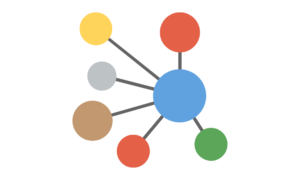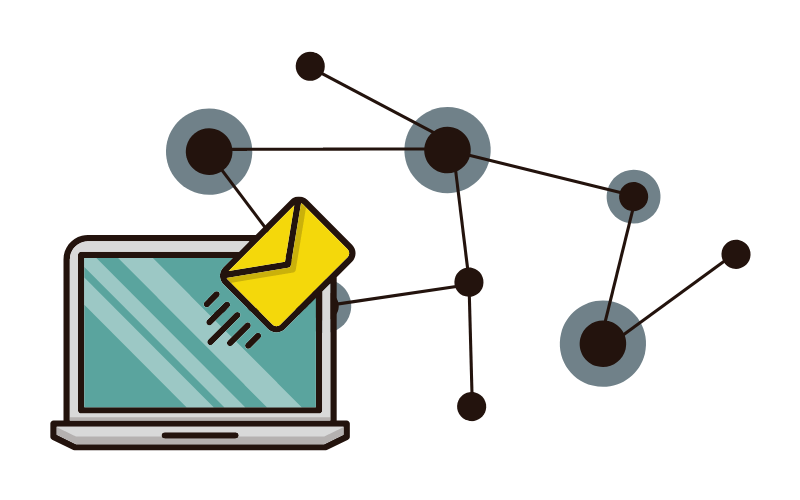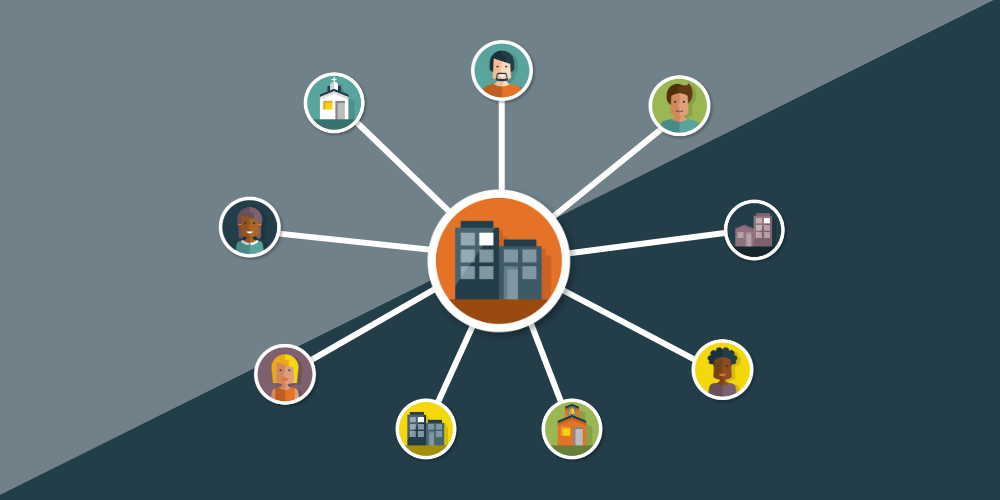Network science offers powerful insights into how organizations can work together to address intricate social and environmental issues. One particularly powerful structure is the hub-and-spoke network model. Often used in contexts ranging from transportation to communication systems, this model can also be applied in an inter-organizational context, where it represents a centralized network structure comprising a lead entity and several partner organizations. Let’s dig in and answer a common question we hear: What is a hub and spoke network? Here’s the network science-informed answer.
Table of Contents
What is a Hub and Spoke Network?

This is comparable to other network structures, like closed networks, where many members interact with one another or open networks, where connections are not common but are still more distributed across partners.

Get our monthly newsletter with resources for cross-sector collaboration, VNL recommended reading, and upcoming opportunities for engaged in the “network way of working.”
Unpacking the Strengths of the Hub-and-Spoke Network
The hub-and-spoke model is admired for several reasons. It provides:
- Centralized Coordination: The hub ensures all spoke organizations are working synergistically towards a common goal, minimizing duplication of efforts and promoting alignment of strategies.
- Efficient Communication: With a direct line to each partner, the hub ensures clear and consistent messaging, reducing the potential for communication mishaps.
- Streamlined Resource Allocation: The hub has the overarching view of the network, allowing it to allocate resources effectively based on the strategic needs of the network.
Recognizing the Limitations of the Hub-and-Spoke Network
While the hub-and-spoke model offers distinct advantages, it’s not always the optimal structure for every context. The model might be less suitable when:
- The central organization doesn’t have the capacity or resources to effectively manage and coordinate the network.
- There’s a need for a more collaborative decision-making process involving all partner organizations.
- There’s a requirement for spoke organizations to frequently interact or collaborate directly with each other, bypassing the hub.
Examples of Hub-and-Spoke Networks
The hub-and-spoke structure is successfully used across diverse contexts. For instance, the United Nations employs this model, with the UN Secretariat serving as the hub that coordinates the activities of its many member countries. Similarly, airlines often organize their routes around a hub-and-spoke model to maximize efficiency and minimize costs. Some community networks using the Collective Impact model organize themselves as a hub and spoke network, where partner organizations work through the central backbone organization.
Creating an Effective Hub-and-Spoke Model: Tips for Success
Developing a successful hub-and-spoke network involves strategic planning and execution. Here are a few pointers:
- Identify a Robust Hub: The central organization should possess the necessary resources and capabilities to effectively manage and coordinate the network.
- Establish Efficient Communication Protocols: Clear, standardized communication channels between the hub and spokes can prevent misunderstandings and ensure timely information flow.
- Foster Trust and Transparency: Building trust and fostering transparency within the network can enhance cooperation and collaborative efforts.
Comparing and Contrasting: Hub-and-Spoke vs Other Network Models
Understanding the hub-and-spoke model is just one part of the networking puzzle. Let’s contrast it with two other well-known network structures – the fully connected network, and the decentralized network.
Hub-and-Spoke vs Fully Connected Network:
A fully connected network, as the name suggests, is a network where all nodes are directly connected to each other. This structure ensures direct communication paths between all partners. However, it can become complex and hard to manage as the number of nodes increases due to the volume of connections.
In contrast, a hub-and-spoke network is simpler, as each spoke communicates directly only with the hub. This centralization can streamline coordination but also creates a reliance on the hub. It’s ideal when centralized control is necessary, while a fully connected network is preferred when direct interaction among all partners is required.
Hub-and-Spoke vs Decentralized Network:
In a decentralized network, there isn’t a single central hub. Instead, multiple nodes serve as hubs, each managing a portion of the network. This can allow for more direct collaboration among partner organizations and reduces dependency on a single hub.
While the hub-and-spoke model centralizes control and decision-making, the decentralized network shares control across several nodes, creating a balance of power. A hub-and-spoke model may be more suitable when a strong lead organization can effectively manage the network, whereas a decentralized network may be beneficial when it’s important to distribute control and decision-making.
PARTNER CPRM: Your Companion for Mapping and Tracking Networks

PARTNER is an indispensable tool for planning, managing, and evaluating hub-and-spoke networks, providing valuable insights to guide strategic decision-making.
Get a Taste of PARTNER CPRM – Request a Demo Today!
If you’re keen to explore how PARTNER CPRM can enhance your network’s effectiveness, we encourage you to request a demo today! Experience firsthand how this tool can bolster your ability to manage, evaluate, and fortify your hub-and-spoke network.
Frequently Asked Questions (FAQs)
A: Yes, as networks evolve, so can their structures. Depending on its growth and evolving dynamics, a hub-and-spoke network might transform into a more decentralized model or a hybrid structure.
A: Effective risk management can be achieved through capacity building within spoke organizations, clear communication protocols, and contingency planning. This ensures that the network can function effectively even when the hub faces constraints.
A: While traditional hub-and-spoke networks revolve around a single hub, more complex variations can feature multiple hubs, each coordinating a subset of spoke organizations. This can be particularly useful in large or geographically dispersed networks.
A: Success can be evaluated through various metrics such as the efficiency of communication, the level of collaborative outcomes, the satisfaction of partner organizations, and the effective allocation of resources. Regular reviews can help adjust strategies and improve network performance.
Mastering the Art and Science of Network Design
With its unique strengths and strategic advantages, the hub-and-spoke model is a powerful structure for inter-organizational collaboration, particularly when centralized coordination is vital. However, understanding its nuances and potential limitations is key to leveraging it effectively.
With a tool like PARTNER CPRM, you can gain valuable insights into your network’s dynamics, paving the way for informed decision-making. Request a demo today and tap into the transformative power of network science!






